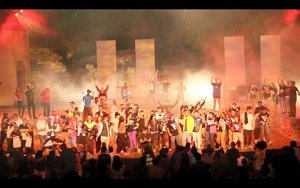 After filing out of Walt Disney Concert Hall this past Sunday after the second and final performance of Benjamin Millepied’s “L.A. Dance Project,” I couldn’t help but think that I had witnessed the real L.A. Dance Project the previous evening at the Fifth Annual J.U.i.C.E. Hip-Hop Dance Festival at the Ford Amphitheatre.
After filing out of Walt Disney Concert Hall this past Sunday after the second and final performance of Benjamin Millepied’s “L.A. Dance Project,” I couldn’t help but think that I had witnessed the real L.A. Dance Project the previous evening at the Fifth Annual J.U.i.C.E. Hip-Hop Dance Festival at the Ford Amphitheatre.
Saturday evening’s fest was an exciting showcase of street dance from local companies. Powered by grants and community support, producer Emiko Sugiyama has pulled together a night of hip-hop dance for the past three years to benefit the nonprofit weekly hip-hop arts program called J.U.i.C.E., Justice by Uniting in Creative Energy. The collective meets every Saturday afternoon at the MacArthur Park Recreation Center and every Thursday evening at Chuco’s Justice Center in Inglewood and provides instruction in the four elements of hip-hop: MCing, DJing, B-boying and graffiti writing.
While Millepied’s Project boasted beautiful dancers and playfully intricate choreography, there was nothing particularly L.A. about the performance, except for the costumes designed by Kate and Laura Mulleavy of L.A.’s Rodarte. By contrast, J.U.i.C.E. was bursting with dance forms, like popping, breaking and krumping, that live — and some were born — on the streets of Los Angeles. Which L.A. did the Music Center’s Project spring from, and which residents did it hope to reach, touch and represent?
This might be a comparison of apples and oranges. But it also underscores the duality of things: high and low culture, street and stage/studio dance, rich and poor. My point is to highlight the richness of local L.A. dancers and dance companies, not bash another man’s passion project. Millepied’s Project has raised eyebrows because of all of the attention it has received. The two events allow us to compare how both worlds coexist and interact differently with the community.
Standing and cheering at the conclusion of J.U.i.C.E, I felt great pride in our local dance scene. Solo artist Boogie Frantick combined elements of popping and miming as he slid in slow motion, pulsed and rode the rhythms of Led Zeppelin’s “Stairway to Heaven.” Representing Lux Aeterna, Jacob “Kujo” Lyons and Teresa “Toogie” Barcelo traced a flirty courtship through seemingly impossible lifts and weight-balancing moves. Toogie also led four other women in vintage dress in a classy exhibition of body rolls, popping and spatial exploration. Rocking old-school moves and putting hip-hop history on display shaped Versa-style’s piece. The six young boys of Baneful Brew are almost too funky for their age. They nailed Boogiezone founder Elm Pizarro’s choreography, and looked as competent as “So You Think You Can Dance” contestants. The b-boy spins, flips and splits of the four guys from 2nd Nature also screamed virtuoso. The Underground, a newly formed street dance company featuring Lil’ C and Miss Prissy, brought the raw feeling and energy of krump to the stage. Starting with choreographed movement, the scene exploded into a celebratory freestyle session emphasizing the improvisational nature of krump.
Stamping a project with the words Los Angeles is only part of the package. J.U.i.C.E. affirmed to me that Los Angeles dance, dancers and companies are thriving, and whether they receive ample funding and recognition or not, they continue to fluorish on our streets, muscle their way onto our stages and represent Angeleno culture.
—Jessica Koslow, Culture Spot LA
For more information about J.U.i.C.E., visit rampartjuice.com.
Note: Jessica Koslow produced The Underground’s first-ever live show at USC on Sept. 5.






As a funder of LA Dance Project, sadly I find myself in the position of wholehearted agreeing with your reflections. LA Dance Project was a disappointment to say the least. Where was the LA in the Project? There is vibrancy and culture that speaks to Los Angeles, lets celebrate the marvels of our dynamic city.
super dope